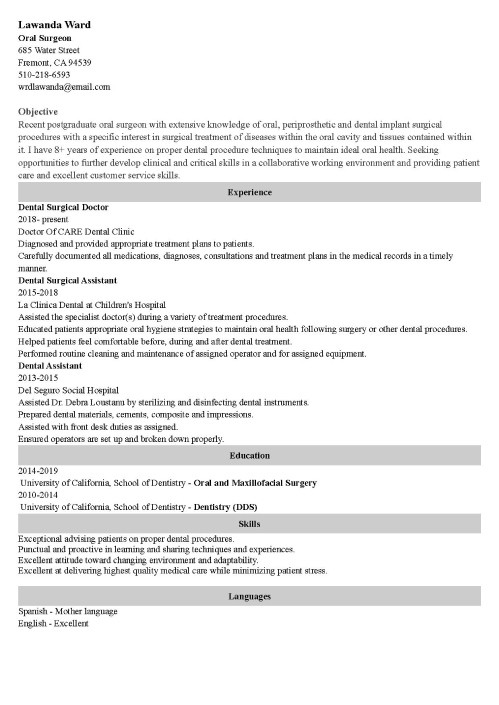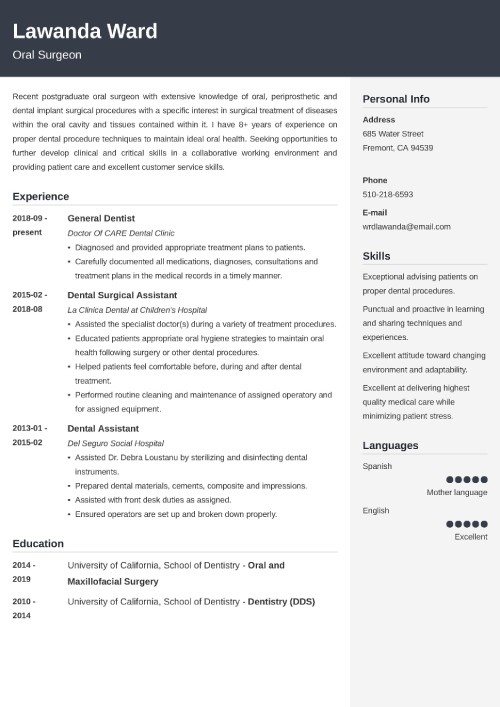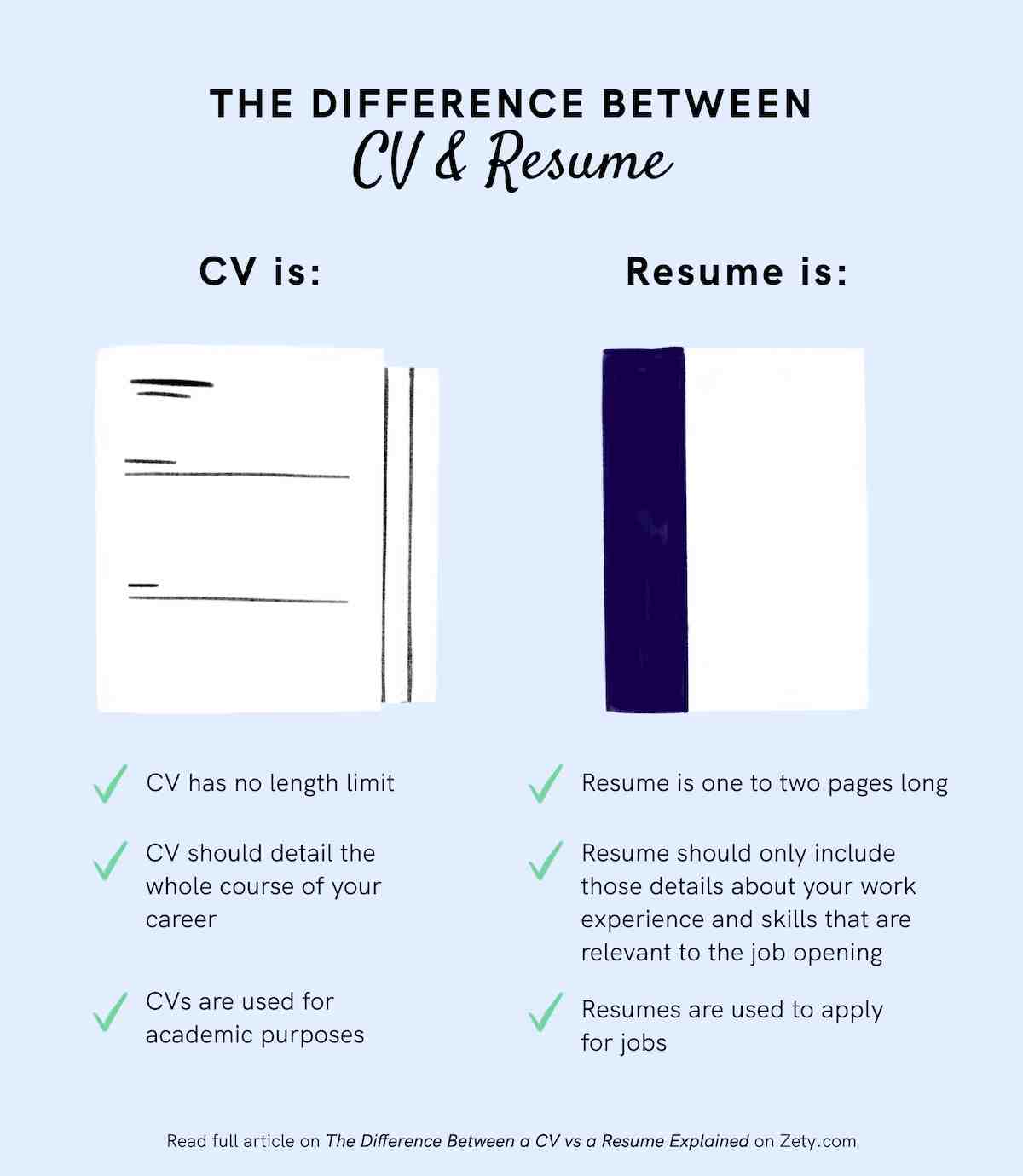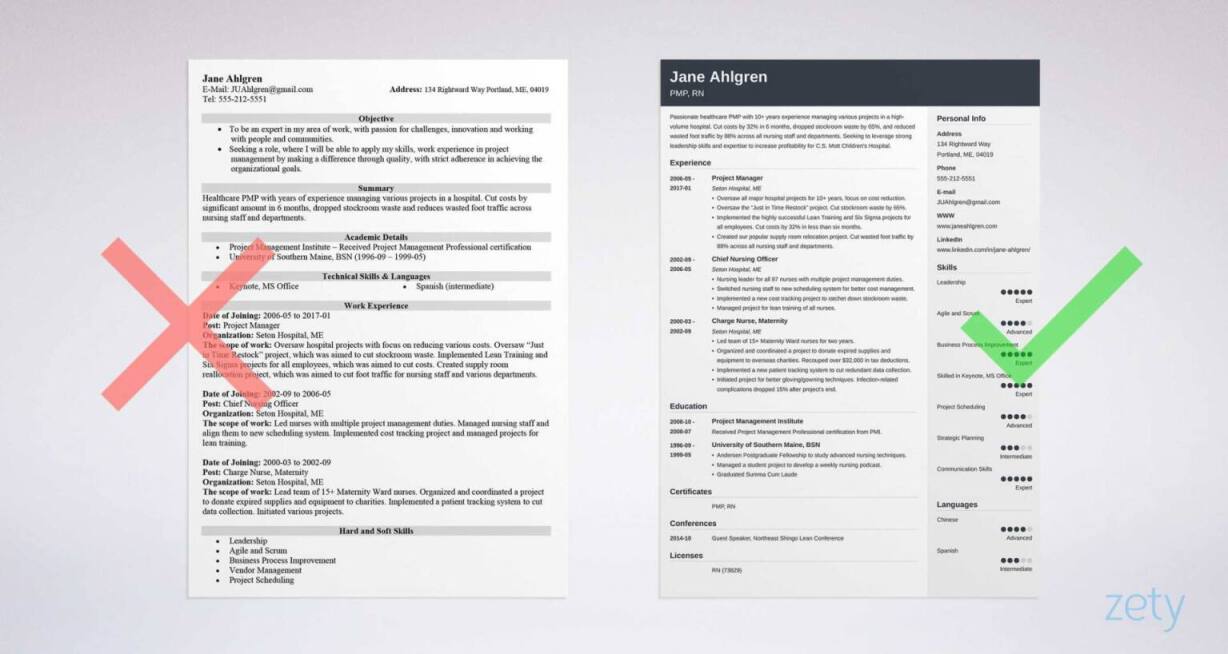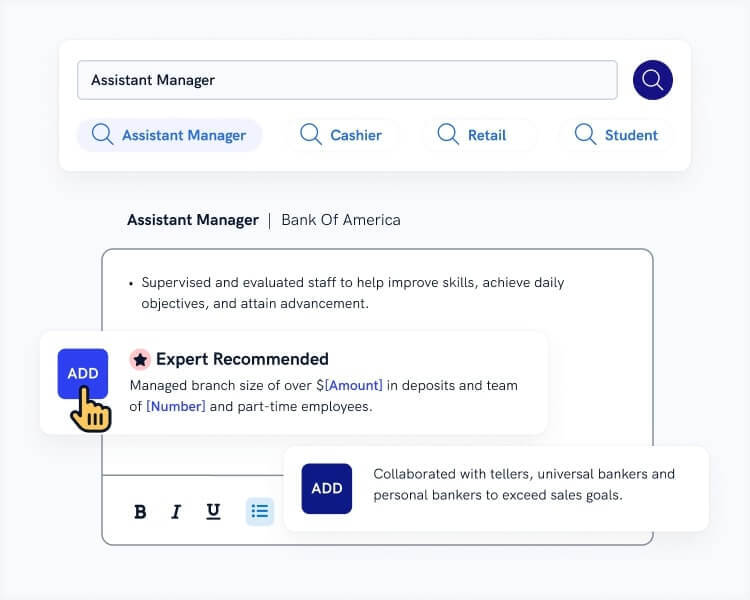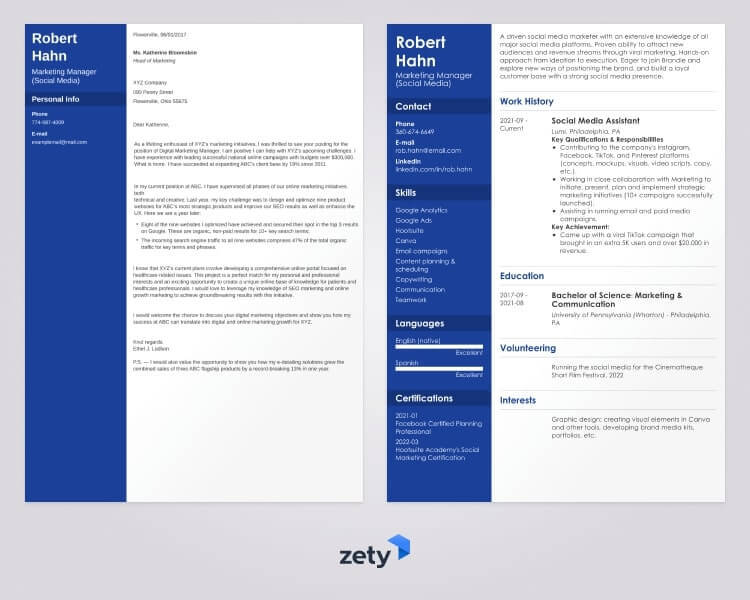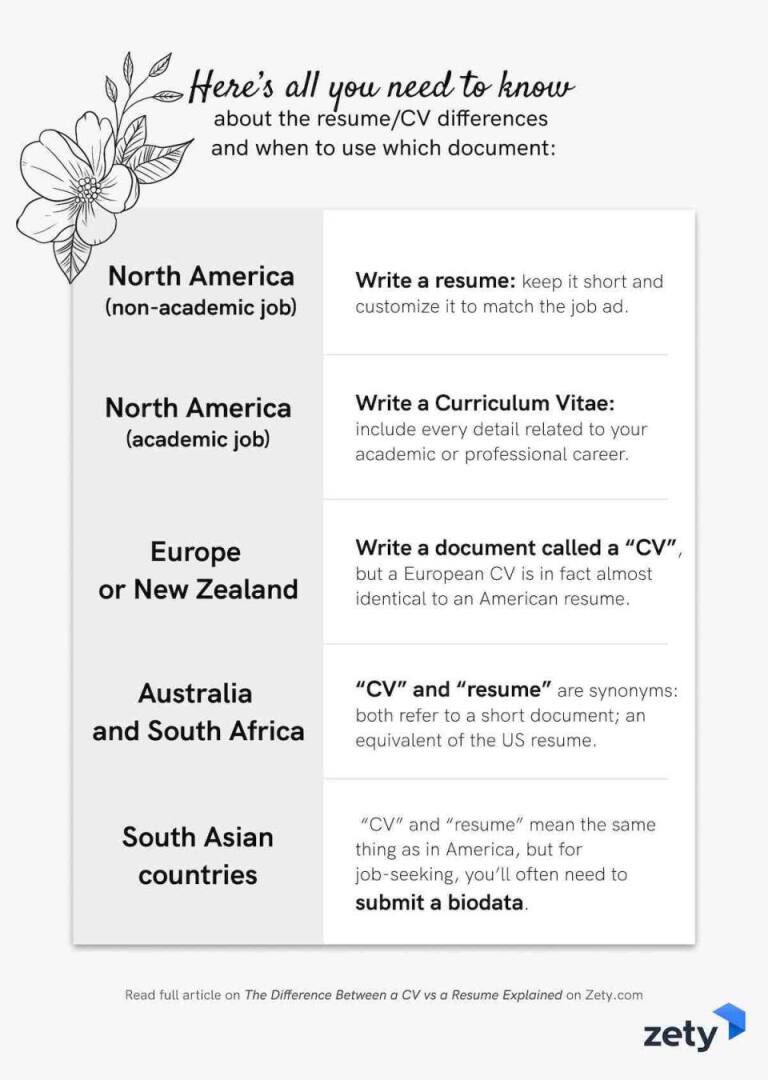What is the difference between cv and resume
What is the difference between cv and resume
Резюме и CV: синонимы или два разных документа?
Вы наверняка много раз встречали слово “CV”. Расшифровывается это так — Curriculum Vitae (“ход жизни”). Чаще всего эту фразу можно встретить когда речь идет о резюме и складывается впечатление, будто это одно и то же. Если же прочитать про реальное значение CV, то вы увидите, что не так уж они с резюме и одинаковы.
Так в чем правда?
Резюме и CV — это одно и то же? Или же это разные понятия и тогда в каких конкретных случаях нужно использовать каждое из них?
Резюме и CV — это два отдельных документа и используют их для разных целей.
В этой статье мы рассмотрим эти два понятия. Разберемся в каких случаях подходит тот или иной документ и в их отличиях, чтобы вы смогли использовать правильный документ по ситуации.
Если говорить об отечественном рынке труда, тогда резюме и CV — это два взаимозаменяемых синонима. И если в описании к вакансии вас просят прислать CV, то вы можете смело отправлять свое резюме.
Однако, если речь идет про зарубежный рынок труда, например США или Канада, то понятия резюме и CV действительно имеют существенные различия и каждое выполняет свою собственную функцию.
А теперь давайте узнаем, что такое CV и резюме, что между ними общего и чем они отличаются.
Что такое CV?
Если исходить из терминологии регионов, где CV и резюме это разные понятия, то в CV описывают историю своего высшего образования и академической деятельности, дополняя информацию фактами про опубликованные работы, награды и заслуги.
Формат CV чаще всего используют научные работники, для описания своей карьерной истории.
Как написать CV?
В CV описывают опыт работы в хронологическом порядке. Каждому пункту уделяют внимание, максимально описывая все детали предыдущей профессиональной деятельности. И хотя CV можно создать для каждой профессии, чаще всего этот формат используют журналисты, специалисты медицинской сферы, научные работники и т.п, для детального описания всего своего профессионального пути: обучение, практика, стажировки, научные труды, публикации и достижения.
Какой идеальный объем документа?
Не существует определенного объема CV. Человек с многолетним опытом и большим количеством опубликованных работ может иметь CV, которое может достигать даже пять и более страниц.
CV не придется адаптировать под каждую вакансию. Единственное, что нужно писать конкретно под каждую вакансию в этом случае — это сопроводительное письмо. С его помощью вы проявляете мотивацию в получении должности и заинтересованность в компании.
Что такое резюме?
Вы используете резюме, для того чтобы предоставить краткую сводку про ваш опыт работы, навыки, достижения и образование.
Резюме нужно для того, чтобы предоставить рекрутеру и работодателю общее представление о вашем опыте работы.
В зависимости от того, какой формат резюме вы выберете, вы будете описывать информацию про опыт работы в порядке обратной хронологии, то есть от самого крайнего до первого места работы. А если опыт работы мал, либо отсутствует, вы будете писать про свое образование, практику и стажировки.
Помимо раздела про опыт работы, резюме состоит из множества других важных разделов, в которых описывается основная информация про вас.
Составляя резюме, адаптируйте информацию о себе под каждую конкретную позицию, на которую вы претендуете. Помните, объем хорошего резюме составляет не более чем 2 страницы. Ищите идеи того, как оформить ваш документ? В нашей колекции вы найдете не один образец CV на русском языке.
Так чем же резюме отличается от CV?
CV vs Резюме: основные отличия
Откликаясь на вакансию, вы можете отправить как резюме, так и CV. Оба варианта подойдут. Тем не менее, есть несколько четких различий между ними, о которых вам нужно знать, особенно если вы ищете работу в странах, где эти понятия разделяют.
Мы подготовили сравнительную таблицу, которая поможет вам выбрать правильный формат для конкретной вакансии:
| Резюме | CV | |
|---|---|---|
| Размер документа? | Идеальный размер 1 страница, максимум 2. | Пишите столько, сколько нужно. Размер может достигать даже 5 страниц и более. |
| Из чего состоит? | Зависит от описания вакансии и ваших возможностей. В основном сюда входит контактная информация, опыт работы, навыки и образование. | Вы описываете всю вашу деятельность и достижения, начиная с высшего учебного заведения и заканчивая всеми вашими профессиональными достижениями. |
| Адаптивность? | Резюме должно соответствовать вакансии и содержать актуальные навыки. | Ваше CV это история вашей карьеры и она не меняется. По мере продвижения в карьере добавляется новая информация. |
| Где использовать? | Во многих странах мира, например в Австралии, Индии или Южной Африке, резюме и CV — это одно и то же. А вот в США<>США это абсолютно разные документы. | В Европе, Великобритании, Новой Зеландии само слово “резюме” используется редко, а словом “CV” обычно называют короткий вариант. |
| Как выглядит? | Есть 4 основных формата резюме, таких как: резюме с обратной хронологией, функциональное, комбинированное и таргетированное резюме. От того, какой формат вы выберете и будет зависеть внешний вид вашего документа. | Ваше CV будет выглядеть как список ваших академических и профессиональных достижений в хронологическом порядке. Документ выглядит как автобиография из вашей профессиональной деятельности. |
В каких случаях нужно использовать резюме и CV?
Какой лучше выбрать формат документа: резюме или CV?
Все еще сомневаетесь какой документ отправлять на вакансию? Рекрутеры практически всегда указывают в вакансиях формат документа, который они ожидают получить от кандидата.
Если же выбор все еще не совсем очевиден, удобно иметь сразу 2 готовых документа. Вы всегда можете начать с отправки короткого резюме, а если у вас попросят более расширенную версию, не помешает подготовить и CV.
Чтобы лучше понимать как может выглядеть CV предлагаем вам посмотреть образцы для врача, учителя и адвоката.
Нужно ли добавлять фотографию в резюме или CV?
Наверняка вы столкнетесь с вопросом необходимости размещения фото в резюме и CV. Для чего нужна фотография и как выбрать подходящее фото?
Одинаковые ли правила действуют для фото в резюме и CV?
Если вы рассматриваете вакансию в Великобритании, США и Канаде — абсолютно нормально НЕ добавлять свое фото. В большинстве европейских стран, напротив, фото желательно и наличие его в вашем документе воспримут позитивно. И все же, это не обязательное условие, до тех пор, пока так не написано в вакансии. Исключением будут только медийные вакансии: актер, модель и т.п.
Необходимость фото в резюме определяется выбранной должностью, а также страной, в которой находится ваш будущий работодатель.
Для того, чтобы подробнее разобраться в этом вопросе, мы подготовили полезную статью про роль фотографии в резюме. В этой статье мы рассказываем про ключевую задачу фотографии в резюме, в каких случаях нужно или не нужно добавлять фото.
Подводим итоги
Основные отличия между резюме и CV состоят в том, для каких целей их используют, в содержании и объеме документа.
Размер CV не имеет общепринятых ограничений. Вы можете описать все свои достижения и опыт, поэтому размер может выйти за пределы даже 3-х страниц. Резюме же обычно состоит максимум из 2-х страниц.
В CV мы максимально подробно описываем информацию про образование, академическую деятельность (если такая есть), а также про опыт работы, навыки, достижения, награды и сертификаты. Резюме же состоит из кратких фактов о ваших предыдущих местах работы, основных навыках, достижениях, и дополнительной информации, релевантной для вакансии.
CV, как правило, отправляют на академические должности, а резюме на все остальные сферы деятельности.
Данные отличия имеют место в таких странах как США и Канада.
В то же время, в Новой Зеландии и в Европе, включая Великобританию, CV используют для обозначения того же, что и резюме в США. То есть, в этих странах понятие CV используют для описания краткой информации про ваш профессиональный опыт. Слово “resume” используется редко.
Чтобы не запутаться, проще всего внимательно изучить описание вакансии, нет ли в нем конкретных требований для формата документа. Если вы всё же не понимаете, какой именно формат от вас ожидают — не помешает подготовить оба варианта.
Чаще всего CV используют для профессий связанных с научной, медицинской, журналистской деятельностью, для писателей. А для всех остальных случаев используют привычное для нас резюме.
Главные отличия резюме и CV: объем документа, цель написания и содержание.
Если вам необходимо иметь два этих документа, мы рекомендуем составить сначала расширенное CV, а в резюме обобщить всю написанную в CV информацию, которая обязательно должна быть адаптирована под каждую вакансию, на которую вы будете отправлять свое резюме.
Когда вы ищете свою идеальную работу или планируете продвигаться по карьерной лестнице, будьте уверены в том, что имеете все необходимые документы для этого. Наличие качественно подготовленных резюме и CV означает то, что вы готовы быстро предоставить всю ключевую информацию о себе, как о хорошем и толковом специалисте.
Чтобы увеличить шансы в получении работы своей мечты, используйте качественные шаблоны резюме. Вы можете составить современное и толковое CV или резюме, всего за пять минут; проверьте нашу онлайн галерею с актуальными шаблонами резюме чтобы найти лучший макет для вас. Составлять Curriculum Vitae по шаблону онлайн проще, чем делать это в Word.
CV vs. Resume: The Difference and When to Use Which
Ever wondered why a Brit applies with a CV and an American with a resume? And why does an Aussie apply with both? There are a few differences between the two types of application documents and this article will straighten out your queries as well as tell you where in the world you are likely to use which document. Let me kick off the bonanza by introducing the contender in the blue corner…
A CV (Curriculum Vitæ, which means ‘course of life’ in Latin) is an in-depth document that can be laid out over two or more pages and it contains a high level of detail about your achievements, a great deal more than just a career biography. The CV covers your education as well as any other accomplishments like publications, awards, honors, etc.
The document tends to be organized chronologically and should make it easy to get an overview of an individual’s full working career. A CV is static and doesn’t change for different positions, the difference would be in the cover letter.
Resume:
A resume, or résumé, is a concise document typically not longer than one page as the intended reader will not dwell on your document for very long. The goal of a resume is to make an individual stand out from the competition.
The job seeker should adapt the resume to every position they apply for. It is in the applicant’s interest to change the resume from one job application to another and to tailor it to the needs of the specific post. A resume doesn’t have to be ordered chronologically, doesn’t have to cover your whole career like, and is a highly customizable document.
Differences:
As stated, three major differences between CVs and resumes are the length, the purpose, and the layout. A resume is a brief summary of your skills and experience over one or two pages, a CV is more detailed and can stretch well beyond two pages. The resume will be tailored to each position whereas the CV will stay put and any changes will be in the cover letter.
A CV has a clear chronological order listing the whole career of the individual whereas a resume’s information can be shuffled around to best suit the applicant. I would say the main difference between a resume and a CV is that a CV is intended to be a full record of your career history and a resume is a brief, targeted list of skills and achievements.
CV – long, covers your entire career, static
Resume – short, no particular format rule, highly customizable
Usage around the world:
A resume is the preferred application document in the US and Canada. Americans and Canadians would only use a CV when applying for a job abroad or if searching for an academic or research-oriented position.
In the UK, Ireland, and New Zealand, a CV is used in all contexts and resumes aren’t used at all. The CV prevails in mainland Europe and there is even a European Union CV format available for download.
In Germany, the CV is more commonly known as a Lebenslauf (true to the Latin origins) and is only one of many application documents poor German job seekers must produce to get an interview.
In Australia, India, and South Africa, the terms resume and CV are used interchangeably. The term resume is used more for jobs in the private sector and CV is more commonplace when applying for public service positions.
Question:
So what gives if you apply for an American company in Europe or vice versa? The jaded folks in HR will accept both types although I would recommend you use the local version. It’s not that hard to convert your document after all and if you hit a brick wall, just ask me for help.
Which do you prefer, the CV, the resume, both, none? Please share your experience in the comments below!
The Difference Between a Resume and a Curriculum Vitae
Adrian Mange / The Balance
What is the difference between a resume and a CV? When should you use a resume, and when is it better to use a curriculum vitae?
The primary differences between a resume and a curriculum vitae (CV) are length, what is included, and what each is used for. While both are used in job applications, a resume and a CV are not always interchangeable.
CV vs. Resume: What’s the Difference?
Most resumes in the United States are competency-based: they are personal marketing documents intended to showcase the candidate’s skills, notable achievements, and work experience to the greatest advantage.
U.S. curriculum vitae, submitted for jobs in academia, scientific research, and medical fields, are credential-based, providing a comprehensive (and often lengthy) listing of one’s education, certifications, research experience, and professional affiliations and memberships.
What Is a Curriculum Vitae?
A curriculum vitae (CV) provides a summary of your experience and skills. Typically, CVs for entry-level candidates are longer than resumes—at least two or three pages. CVs for mid-level candidates who have amassed numerous publications tend to run much longer.
CVs include extensive information on your academic background, including teaching experience, degrees, research, awards, publications, presentations, and other achievements.
CVs are lengthier than resumes and include more information, particularly details related to one’s academic and research background.
A curriculum vitae summary is a one-to-two-page, condensed version of a full curriculum vitae. A CV summary is a way to quickly and concisely convey one’s skills and qualifications. Sometimes large organizations will initially ask for a one-page CV summary when they expect a large pool of applicants.
What to Include in Your Curriculum Vitae
Your curriculum vitae should include your name, contact information, education, skills, and experience.
In addition to the basics, a CV includes research and teaching experience, publications, grants and fellowships, professional associations and licenses, awards, and other information relevant to the position you are applying for.
Start by making a list of all your background information, and then organize it into categories.
Review a Sample CV
Here is an example of a curriculum vitae. Download the CV template (compatible with Google Docs and Word Online), review more samples, or continue reading for more information.
What Is a Resume?
A resume provides a summary of your education, work history, credentials, and other accomplishments and skills. There are also optional sections, including a resume objective and a career summary statement.
Resumes are the most common document requested of applicants in job applications.
A resume should be as concise as possible. Typically, a resume is one page long, although sometimes it can be as long as two or three pages.
Resumes often include bulleted lists to keep information concise.
Resumes come in a few types, including chronological, functional, and combination formats. Select a format that best fits the type of job you are applying for.
Review a Resume Sample
Here is an example of a resume. Download the resume template (compatible with Google Docs and Word Online), review more samples, or read below for more information.
CV and Resume Writing Tips
Whether you are writing a CV or a resume, there are a few helpful rules you should follow. It’s important to show the hiring manager how you are qualified for the job, what you have to offer the organization, and why you’d be a terrific candidate to interview.
Match your resume or CV to the position. This is most important when writing a resume, but it applies to a CV too. Make sure that you highlight your education, work experience, and skills as they relate to the particular industry or job.
In a CV, for example, if you are applying for a job in education, you might want to put your teaching experience at the top of your CV. In a resume, you might include only the work experience that relates directly to the job you’re applying for. You can also include keywords from the job description in your resume or CV. This will show the employer that you are an ideal fit for the position. Here’s how to match your qualifications to a job.
Use a template. You may want to use a template to structure your resume or CV. This will give your document a clear organization, which will help the employer quickly see your qualifications and experience.
Proofread and edit. No matter whether you use a CV or resume, you need to thoroughly edit your document. Make sure there are no spelling or grammatical errors. If you can, ask someone to proofread it for you. It can be hard to catch your own mistakes.
Make sure your format is uniform—for example, if you use bullet points in one job description, use bullet points in all your job descriptions.
How to Write a Successful Resume
How to Write a Successful CV
U.S. vs. International CVs
While CVs in the U.S. are used primarily when applying for academic, education, scientific, medical, or research positions or when applying for fellowships or grants, candidates for international jobs may be required to submit “CVs” for almost any type of job they apply for.
International CVs
In Europe, the Middle East, Africa, or Asia, employers may expect to receive a “curriculum vitae” (often with an attached photograph) rather than a resume. However, international “CVs” are structured and formatted more like a resume than they are an academic U.S. curriculum vitae.
The Difference Between U.S. and International CVs
The primary difference between a U.S. resume and an international CV is that employers in other countries, unfettered by U.S. employment discrimination laws, require more personal information than one would provide on a resume in the United States
These details vary by country, but can include one’s date of birth, nationality, marital status, and number of children. Here’s how to structure your international curriculum vitae.
Resume and CV Examples
Review resume and curriculum vitae examples and get downloadable templates for a variety of occupations and types of employment:
CV vs Resume: Key Differences to Choose Between the Two
What is a CV? Is it any different from a resume?
Why do some candidates apply with a CV and others use a resume? Is any of the two actually better than the other? Is resume just another word for CV, and vice versa?
In 5 minutes you’ll learn everything you need to know about the CV vs. resume difference.
This guide will show you:
Want to save time and have your resume ready in 5 minutes? Try our resume builder. It’s fast and easy to use. Plus, you’ll get ready-made content to add with one click. See 20+ resume templates and create your resume here.
Sample resume made with our builder—See more resume examples here.
One of our users, Nikos, had this to say:
[I used] a nice template I found on Zety. My resume is now one page long, not three. With the same stuff.
If you’re just looking for the bottom line, here it is:
The Difference
A resume is a one- to two-page document presenting key facts about your professional experience, educational background, and skills. A CV (Curriculum Vitae) is a longer document that details the whole course of your career. A resume is used for job search, a CV—for academic purposes.
Not quite clear? See the detailed overview of a CV versus a resume below:
A (full form Curriculum Vitae which is Latin for “course of life”) is an in-depth document which describes the whole course of your career in full detail. It’s usually two- or three-page long but can just as well be laid out over 10+ pages, if necessary. A Curriculum Vitae contains details about your education, professional career, publications, awards, honors, and other achievements. In the USA and Canada, a CV is used only for academic applications: academic jobs, grants, research fellowships, etc.
To see what it looks like check out the CV example below.
Curriculum Vitae Sample
Want to save time and create your CV in minutes? Use our CV maker. Just fill in the blanks and have a perfectly formatted CV ready for download. See 20+ CV templates and create your CV here.
Sample CV made with our builder—See more templates and create your CV here.
As you can see, what goes on a CV is very detailed and comprehensive: many sections, no bullet points, just plain text (after all, CV meaning is a course of life, no wonder it’s that long!)
Below you’ll see a full list of sections to put on a CV.
What to Include in a CV:
Before we show you a full resume/CV comparison, let’s quickly define résumé.
Resume
A (or résumé, from French “to sum up”) is a short, concise document used for job applications in the US and Canada. The purpose of a resume is to provide recruiters with a brief overview of the candidate’s work history. A good resume should be targeted at a specific job and one to two pages long.
Have a look at the below example made with our builder in US resume format. The difference between a resume and a CV is clear, isn’t it?
American Resume Sample
You can use our convenient Online Resume Builder to create a perfect American Resume. Simply pick one of our resume templates here.
If you want to learn more about how to write a job-winning resume, switch over to: How to Make a Resume for a Job (Samples & a Writing Guide)
Or check out a dedicated example of a resume for your job. We guarantee you’ll find it here: 99+ Resume Examples for All Jobs in the World
What should be on a resume, then?
What to Include on a Resume:
So now you know how should a resume look, but before we move on, a technical thing that confuses many job seekers: How to type a resume?
What’s the Proper Resume Spelling?
Although originally spelled “résumé” in French, in English both forms—”resume” and “résumé”—are correct.
When making a resume in our builder, drag & drop bullet points, skills, and auto-fill the boring stuff. Spell check? Check. Start building a professional resume template here for free.
When you’re done, Zety’s resume builder will score your resume and tell you exactly how to make it better.
The Difference In a Nutshell
The difference between a CV and a resume lies in the length, layout, and purpose of these documents. CVs have no length limit; resumes are typically one to two pages long. A CV details the whole course of the candidate’s academic career; a resume summarizes skills and work experience.
Difference between CV and Resume
Length
Layout
Purpose
CV
In-depth description of your academic and professional experience
For academic placements
Resume
Brief document highlighting your professional experience
For all kinds of jobs
All of the above holds true for the US and Canada.
But what about international applications?
Resume vs. CV: International Differences & When to Use Which
In all of Europe (the UK, Ireland, and other European countries), as well as New Zealand, the term CV is used to describe an equivalent of a US resume: a short, targeted document you use to apply for jobs. There’s no such thing as a “resume” there.
There are only minor, region-specific differences between a New Zealand or European CV and an American resume. To learn more about writing a job CV, see: How to Write a CV for a Job Application
In Australia and South Africa, “Curriculum Vitae” and “resume” are synonyms that can be used interchangeably. Both words stand for a brief, one- to two-page document.
In South Asia, job seekers might need to use a slightly different document: a biodata. It’s a document which contains more personal, “biographical” data (hence the name): date of birth, gender, race, ethnicity, marital status, and salary. It’s commonly used in India and Bangladesh.
If a South Asian employer asks you for a “resume” or a “CV” specifically, don’t send over a biodata. Go for a document that follows the American resume rules.
Plus, a great cover letter that matches your resume will give you an advantage over other candidates. You can write it in our cover letter builder here. Here’s what it may look like:
Key Takeaway
Here’s all you need to know about the resume/CV differences and when to use which document:
I hope this article helped clear up the differences between CVs and resumes. If you’re still not sure about some points, leave a comment. I’ll answer all your CV vs. resume questions!
CV vs. Resume—Here Are the Differences
“Um, what is a CV?” is a question job seekers often find themselves asking. Approach 10 professionals, and odds are high only one or two can tell you the real answer. Good news, you’re about to be one of those few people who know not just what the letters stand for, but how the CV compares to a resume, and whether or not you should have one.
Curriculum Vitae, more commonly referred to by its shorthand abbreviation CV (a Latin term meaning course of life), got tossed around a lot when I was in graduate school. I’m pretty sure I pretended to know what it meant the first time I heard it, only to go home to Google and educate myself before it came up in casual conversation again.
SEARCH OPEN JOBS ON THE MUSE! See who’s hiring here, and you can even filter your search by benefits, company size, remote opportunities, and more. Then, sign up for our newsletter and we’ll deliver advice on landing the job right to you.
I quickly learned that dissertation-defending PhDs didn’t have resumes, they had CVs. Unlike the resume, which lists work history and experiences, along with a brief summary of your skills and education, the CV is a far more comprehensive document. It goes above and beyond a mention of education and work experience and often lists—in thoughtful detail—your achievements, awards, honors, and publications, stuff universities care about when they’re hiring teaching staff. Unlike a resume, which is rarely longer than a one-sided single page, the CV can be two, six, or 12 pages—depending on your professional achievements.
Let’s go over some basics of the CV versus resume.
Want to skip ahead? Check out:
What Is a CV?
As touched upon briefly above, CVs are primarily popular among academics, as graduate students often spend a lot of effort getting their work published during these post-grad years. While higher-education institutions undoubtedly evaluate a potential candidate’s grades and test scores, they’re also eager to see where an applicant’s been published.
“Publish or perish” was a popular sentiment during my two years in graduate school, and it appears not much has changed. I spoke with a couple of my former classmates who went on to obtain doctorate degrees long after I’d left with a master’s degree in hand and an I’ve-had-enough-of-that mindset, and they were quick to reiterate how important getting published is to one’s career, and, of course, the standard academic’s CV.
OK, Anyone Besides Academics?
You’re right, they’re not the only ones who choose the long (sometimes, very long) document over a resume. The website Undercover Recruiter explains that U.S. and Canadian residents need a CV if they’re applying to work abroad, specifically in the U.K., Ireland, and New Zealand. In these countries, “a CV is used in all contexts and resumes aren’t used at all.” Moreover, “The CV prevails in mainland Europe and there is even a European Union CV format available for download,” a super helpful template if you’re confused about how to build one.
What’s the Difference Between a CV and a Resume?
Short answer: Length.
Long answer: The CV’s static in that it’s not a document needing to be tailored for different positions in the way that a resume is. Rather, according to UNC Writing Center, the CV’s a “fairly detailed overview of your life’s accomplishments, especially those most relevant to the realm of academia,” hence the variance in length; an early-stage grad student’s CV is going to be a lot shorter than a sixth-year student preparing to write a dissertation.
The document only changes as your accomplishments grow—you publish the findings of a scientific study, or a short story, or you receive an award as a Teaching Assistant—whereas a resume can and should be modified often as you job search and apply to different companies and positions. At The Muse, we highly encourage you to tailor your resume for each and every job you apply to, even if the job descriptions are similar. (It’ll not only help you stand out, but also ensure you get through the ATS.)
But, How Do I Know When to Use Which?
Fortunately, if you’re still confused about where to begin, remember that almost any job you apply to will let you know what you need. It’s not typically a guessing game. When you apply for a job in New York City, or Minneapolis, or Austin, there’ll likely be clear language on what’s required with the application. Begin looking into overseas opportunities, and it’s probable that the application will explicitly state that you need to submit a CV or resume for consideration.
Seriously though, if you’re truly dumbfounded about what’s needed, it’s OK to ask the point of contact directly, “Would you prefer a resume or CV?” (And in America, the answer will almost always be “resume” since we know that recruiters don’t spend more than six seconds looking, anyways.)
Should I Have a CV Handy?
If you don’t currently have one, I’d recommend creating the doc just in case. You don’t have to stop everything you’re doing right this second, but the next time you go to modify your resume (a familiar and somewhat ongoing practice, I hope), start building it out. If nothing else, it’ll serve a dual-purpose: Not only can you have it handy if you do ever need it, but you’ll also have a running list of everything you’ve ever accomplished, a.k.a., a master resume to pull from as you tailor your own for specific positions.
And there you go, everything you ever wanted to know (plus more!) about the differences between a CV and a resume.




:max_bytes(150000):strip_icc()/ADHeadshot-Cropped-b80e40469d5b4852a68f94ad69d6e8bd.jpg)
:strip_icc()/cv-vs-resume-2058495-edit-7b2c8a2ea35240a39cba5eac58b560df.jpg)
:max_bytes(150000):strip_icc()/2058495v21-5bbce1dbc9e77c0051d545ac.png)
:max_bytes(150000):strip_icc()/2063196_2022-1bda0a77b5304474b0421db7556037a2.jpg)

